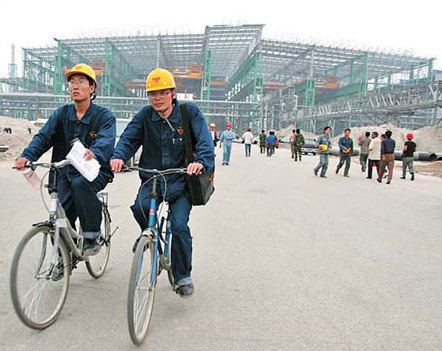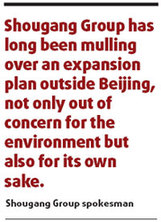To clean up the smog-ridden Beijing skies, the authorities had long been considering relocating steelmaker Shougang Group from the western outskirts of the capital. Seven years ago, China's successful bid to host the Olympics and commitment to a green Games only accelerated the move.
Today, only one of the five blast furnaces in Shougang's Beijing plant is still working and emissions have been cut by 70 percent compared with last year. By the end of 2010, even this blast furnace will have gone.
Today, the remaining Beijing plant hardly resembles its old self.

Workers ride bikes through a Shougang construction site in Caofeidian. [China Daily] |
Located in the middle of the factory, the tranquil Qunming Lake is dotted with pavilions, terraces and an arched bridge, like in any traditional Chinese garden. The only difference is the water, which is recycled from the four huge cooling towers behind the lake.
The gigantic No 4 blast furnace stands under the clear sky in silence. The soot and rust cover the intricate network of stacks and pipes. An old-fashioned train is parked on the tracks.
Lu Chunzheng, director of the iron mill, tells China Daily that the 35-year-old blast furnace ceased operation on the last day of 2007. Before that, the mill produced 1.8 million tons of iron every year, generating an annual revenue of 10 billion yuan.
This is not the only unit that has stopped production in Shougang. The steelmaker started cutting output since July 2005 after the State Council, China's cabinet, approved the plan to relocate its production facilities to Caofeidian in neighboring Hebei province.
Shougang's Beijing plant has slashed monthly production to 200,000 tons since July, says the group's chairman, Zhu Jimin. "This is about 29 percent of our normal output."
This plant, which formerly produced 8.2 million tons of steel a year, will almost halve its output this year to 4.2 million tons, before all production in Beijing is stopped by 2010.
Shougang's efforts have paid off: In the first half of 2008, the emission of sulfur dioxide, soot and dust fell 44.5 percent, 41.7 percent and 39.2 percent respectively, compared with the same period last year.
"We are proud that we have contributed to Beijing's blue sky," says a contented Zhu.
Shougang has made tremendous efforts, and even sacrificed its profits, for a greener Beijing. The steelmaker was hailed as a flagship during the reform of State-owned enterprises (SOEs) after the country embraced the opening-up and reform policy in 1979.
With more autonomy, the company accumulated huge profits in a short time. Shougang's production capacity more than quadrupled from 1.79 million tons in 1978 to 8.24 million tons in 1994. That year, it became the largest steelmaker in the country.
"At that time, workers in Shougang were so proud of their job," recalls a veteran spokesman of the company.